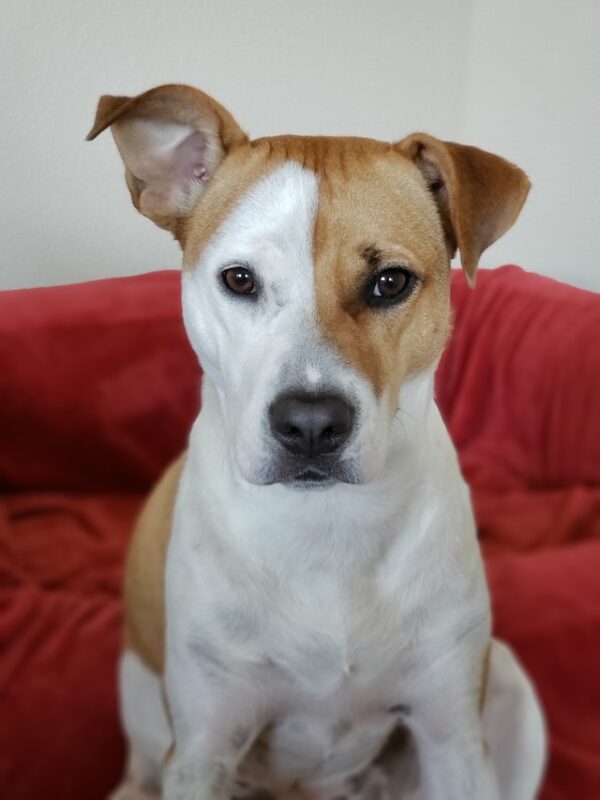Is it Time to Express Your Dog’s Anal Glands?
Posted: 11/06/2023 | BY: Jenna Bruce | Categories: Uncategorized
Have you noticed your dog “scootching” across the carpeting lately? Maybe they are constantly licking their bottom. If so, it might be time to have their anal glands expressed.
What are They Exactly?

Anal glands are scent glands located on both sides of your pup’s rectum. When looking at your pup’s backside, the sacs are located at the four and eight o’clock positions.
When your dog passes a stool, these glands are (usually) naturally expressed, leaving a unique scent on your dog’s stool. There are a few theories as to why dogs have these sacs. Some experts say that the excretion from these glands acts as a territorial marker. Others say the excretion acts as a lubricant to help your pup pass a hard stool. Perhaps these glands developed to perform both duties.
Some Anal Sacs Become Impacted
A majority of dogs will have their anal glands expressed naturally through defecation. But there are some dogs whose glands do not empty as designed. When this happens, the glands become impacted, which can be painful for your dog and make it hard for them to have a bowel movement.
There are a variety of factors that increase the likelihood of a dog developing impacted (and potentially infected) anal glands:
- Chronic skin dermatitis
- Obesity
- Insufficient dietary fiber
- Chronic soft stool
- Food and/or environmental allergies
- Genetics (it is more common for smaller breeds to develop impacted anal glands but no breed is immune to the condition)

With some dogs, their glands will become impacted just once, and it never happens again. This is often the result of the dog having recently completed a round or two of antibiotics. Their gut biome takes a hit, they develop diarrhea, and a week of soft stools causes their glands to become impacted.
With other dogs, impacted anal glands can become a chronic issue. This usually occurs when a dog is obese or suffers from allergies.
Signs It’s Time to Express Your Dog’s Anal Glands
As I mentioned earlier, two main signs a dog has anal sac issues are when they scootch their bottoms along the carpet and lick or bite at their bottom. Other signs include:
The Smell
When your dog’s glands become very full, they begin to leak out a very stinky, pungent smell unlike anything else you’ve probably smelled before. If you’re dealing with an anal sac issue in your house right now, you know the smell I am talking about!
Brown Spots
Yep, they happen. You may notice that wherever your dog sits or lays, they leave brown spots. Again, these will smell horrendous. (Do your family and house a favor and pick up an enzymatic cleaner to get that smell out of your carpet and furniture).
Bleeding
If left untreated, the glands will eventually rupture, and you may see slight bleeding from that area.
Treatment and Prevention of Impacted Anal Glands

If you notice your dog with any of these symptoms, you should bring them to your vet, who will manually express (empty) the anal glands. Should the glands be infected, your vet may also prescribe an antibiotic.
To prevent further occurrences, your vet may suggest adding more fiber to your dog’s diet, getting them on a probiotic to firm up loose stools, or suggesting a bit more exercise if they are overweight.
How Often Do My Dog’s Anal Glands Need to be Expressed?
That really depends on your dog. As I mentioned, many dogs empty their own anal glands each time they have bowel movements. That’s the way nature designed them.
If your dog is of a particular breed (smaller dogs tend to have issues), has allergies, is overweight, etc., they may need to have their anal glands manually expressed. Some pet parents bring their pup to the vet once a month, others a few times a year. The key is really to monitor your dog closely and watch for symptoms. You want to be sure his glands do not become impacted or infected.
A Pet Insurance Plan Can Help You Keep Your Pup Healthy and Happy
Whether it’s impacted anal glands or something a bit more serious, taking your dog to the vet can be costly. Over time, pet parents can spend thousands or even tens of thousands of dollars on medical treatments. Can you comfortably afford to pay these bills?
Pet Insurance Review makes it easy for pet parents to find just the right insurance plan for their fur baby. Our users leave 100% honest reviews so you can know for certain an insurance company will be there when you need them.
Get started today by receiving a free no-hassle quote.
References:
- Morrison, B., DVM, (2022) “Anal Glands on Dogs: What You Need to Know,” Retrieved from: https://www.petmd.com/dog/general-health/anal-glands-dogs
- Schmidt, E., (2022) “What You Need To Know About Anal Glands In Dogs,” Retrieved from: https://www.thedodo.com/dodowell/anal-glands-in-dogs
Disclaimer
The information contained on this blog is intended for informational and educational purposes only and should not be construed as medical advice. It is not a substitute for professional veterinary care. Always consult with your veterinarian before making any changes to your pet's health care or treatment plan.
The authors of this blog are not veterinarians and do not claim to be experts in pet health. The information provided here is based on our own experiences and research, as well as information from reputable sources. However, we cannot guarantee the accuracy or completeness of this information.
We encourage you to do your own research and consult with your veterinarian before making any decisions about your pet's health.
Previous post
2022 Holiday Gift Ideas for Your Fur Babies!Next post
Spoil Them Rotten This Holiday SeasonCompare top pet insurance providers & plans.
Enter your dog’s age in years and months to calculate their age equivalent to human years.
Calculate your dog’s ageEnter your cat’s age in years and months to calculate their age equivalent to human years.
Calculate your cat’s age